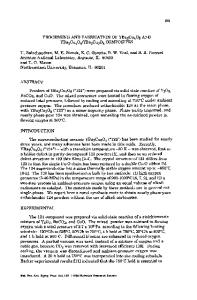Structural and Magnetic Properties of Untwinned Yba 2 Cu 3 O 6+x Single Crystals
- PDF / 270,808 Bytes
- 4 Pages / 420.48 x 639 pts Page_size
- 88 Downloads / 281 Views
STRUCTURAL AND MAGNETIC PROPERTIES OF UNTWINNED YBa 2 Cu 3O6 +1
SINGLE CRYSTALS
DEBRA L. KAISER*, FRANK W. GAYLE*, LYDON J. SWARTZENDRUBER*, WINNIE WONG-NG*, STEVEN F. WATKINS" AND FRANK R. FRONCZEK** * National Institute of Standards and Technology, Materials Science and Engineering Laboratory, Gaithersburg, MD 20899 **Louisiana State University, Dept. of Chemistry, Baton Rouge, LA 70803
ABSTRACT We have conducted structural and magnetic investigations on thermomechanically-detwinned YBa 2 Cu3 0 6 +. single crystals. Single crystal xray diffraction studies on a fully untwinned crystal with a superconducting onset temperature of 54 K have revealed that oxygen atoms in the basal plane are offset from the crystallographic mirror plane in the a direction, leading to "zig-zag" Cu-O chains. Magnetic measurements on untwinned and twinned crystals at 77 K indicate low levels of flux pinning in both crystals, with a slightly larger amount of pinning in the twinned crystal.
INTRODUCTION Fully untwinned single crystals of the high temperature superconductor YBa 2 Cu 3 O6+x (YBCO) offer unique opportunities for scientific study. With such crystals it will be possible to determine the role of twin boundaries in important phenomena such as flux pinning and to resolve a-b anisotropy of physical properties. In addition, single crystal structure determinations have been complicated by the presence of twins, in that data analysis has required the deconvolution of the twinned structure from the unit cell configuration. Structural, magnetic and transport data on untwinned crystals are thus important to the development of both the technology and theory of high temperature superconductivity. Fully untwinned YBCO single crystals have recently become available through the development of a thermomechanical process for twin removal [1]. In this paper, we present further developments in thermomechanical detwinning and the results of structural and magnetic studies on untwinned crystals.
EXPERIMENTAL The thermomechanical process for twin removal depends upon ferroelastic behavior found to exist in the phase and should be generally applicable to the layered perovskite-type phases containing accommodation or transformation twins. In this procedure, a uniaxial compressive stress is applied to a twinned crystal along an _/b-axis at elevated temperature. The twin variant with the unit cell dimension I aligned along the direction of applied stress is favored. The unfavored twin domains transform to the favored variant by interchanging A and b axes (equivalent to a shift of the oxygen atoms from [0½0] to [400] sites), either through a massive transformation or by migration of twin boundaries. The setup for applying a load to a crystal is shown in Fig. 1. Two fused quartz slides coated with about 200 A of gold were held in a parallel geometry by a clamp. The spacing between the slides was established by a thickness of gold filler sheets. A crystal (typical dimensions 100-400 pm in the a/b directions and 50-100 pm in the c direction) was stood o
Data Loading...











